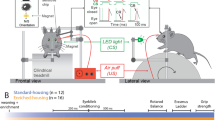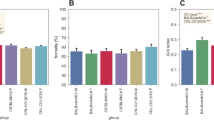Test responses by laboratory mice are unperturbed by more entertaining housing.
Abstract
Mice housed in standard cages show impaired brain development, abnormal repetitive behaviours (stereotypies) and an anxious behavioural profile, all of which can be lessened by making the cage environment more stimulating1,2,3. But concerns have been raised that enriched housing might disrupt standardization and so affect the precision and reproducibility of behavioural-test results (for example, see ref. 4). Here we show that environmental enrichment increases neither individual variability in behavioural tests nor the risk of obtaining conflicting data in replicate studies. Our findings indicate that the housing conditions of laboratory mice can be markedly improved without affecting the standardization of results.
This is a preview of subscription content, access via your institution
Access options
Subscribe to this journal
Receive 51 print issues and online access
$199.00 per year
only $3.90 per issue
Buy this article
- Purchase on Springer Link
- Instant access to full article PDF
Prices may be subject to local taxes which are calculated during checkout

Similar content being viewed by others
References
Van Praag, H., Kempermann, G. & Gage, F. H. Nature Rev. Neurosci. 1, 191–198 (2000).
Würbel, H. Trends Neurosci. 24, 207–211 (2001).
Chapillon, P., Manneche, C., Belzung, C. & Caston, J. Behav. Genet. 29, 41–46 (1999).
Gärtner, K. in Proc. Int. Joint Meeting 12th ICLAS General Assembly and Conference & 7th FELASA Symposium, SECAL, Madrid 207–210 (1999).
Crabbe, J. C., Wahlsten, D. & Dudek, B. C. Science 284, 1670–1672 (1999).
van der Staay, F. J. & Steckler, T. Genes Brain Behav. 1, 9–13 (2002).
Würbel, H. Genes Brain Behav. 1, 3–8 (2002).
Van Loo, P. L. P., Van Zutphen, L. F. M. & Baumans, V. Lab. Anim. 37, 300–313 (2003).
Author information
Authors and Affiliations
Corresponding author
Ethics declarations
Competing interests
The authors declare no competing financial interests.
Rights and permissions
About this article
Cite this article
Wolfer, D., Litvin, O., Morf, S. et al. Cage enrichment and mouse behaviour. Nature 432, 821–822 (2004). https://doi.org/10.1038/432821a
Published:
Issue Date:
DOI: https://doi.org/10.1038/432821a
This article is cited by
-
Impact of enriched environment on motor performance and learning in mice
Scientific Reports (2024)
-
The effects of age, size, and cage complexity on the behaviour of farmed female chinchillas (Chinchilla lanigera)
Scientific Reports (2023)
-
Conventional laboratory housing increases morbidity and mortality in research rodents: results of a meta-analysis
BMC Biology (2022)
-
Apparatus design and behavioural testing protocol for the evaluation of spatial working memory in mice through the spontaneous alternation T-maze
Scientific Reports (2021)
-
The Relevance of Operant Behavior in Conceptualizing the Psychological Well-Being of Captive Animals
Perspectives on Behavior Science (2020)
Comments
By submitting a comment you agree to abide by our Terms and Community Guidelines. If you find something abusive or that does not comply with our terms or guidelines please flag it as inappropriate.



